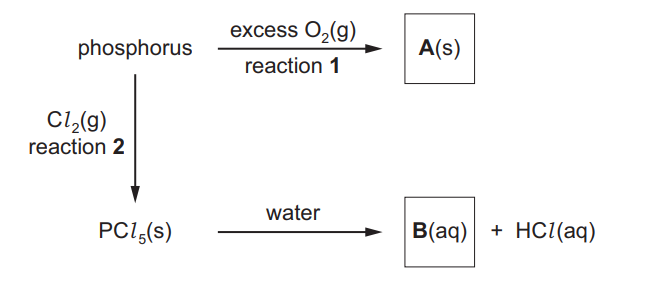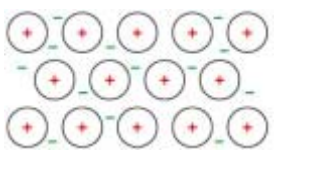Question
Sodium oxide, Na2O, is a white crystalline solid with a high melting point.
(a) Write an equation for the reaction of sodium with oxygen, forming sodium oxide.
Include state symbols.
(b) Explain why sodium oxide has a high melting point.
(c) When sodium oxide reacts with water an alkaline solution is obtained.
(i) Explain why the solution obtained is alkaline. You should use the Brønsted-Lowry theory
of acids and bases in your answer.
(ii) Calculate the pH of the solution obtained when 3.10g of sodium oxide are added to 400cm3
of water.
(d) Use the data below, and other suitable data from the Data Booklet, to calculate the lattice
energy of sodium oxide, ΔHθlatt Na2O(s).

(e) State how ΔHθlatt Na2S(s) differs from ΔHθlatt Na2O(s).
Indicate this by placing a tick (✓) in the appropriate box in the table.

Answer/Explanation
Answer: (a) 4Na(s) + O2(g) → 2Na2O(s)
balanced with all formulae correct
state symbols
(b) giant ionic
strong bond / attraction between
AND
positive and negative ions / anions and cations / Na+ and O2– / oppositely charged ions
(c)(i) the reaction produces sodium hydroxide / hydroxide ions / OH– ions
the hydroxide ions can receive / accept H+ ions / protons
(c)(ii) Calculation of Na2O moles 3.10g / 62 OR 0.05
Calculation of [OH–] 0.05 × (2 / 0.400) = 0.25 mol dm–3
Calculation of pH –log 0.25 = 0.60
14 – 0.60 = 13.40
(d) use of (2 × 109) or 218 and (2 × 494) or 988
use of (0.5 × 496) or 248
use of 416, 142, 844
evaluation of expression correctly
∆Hlat = –416 – (2 × 109) – (0.5 × 496) – (2× 494) – (–142 + 844) = –2572
(e) the lattice energy of Na2S is less exothermic
the sulfide ion is larger than the oxide ion / S2– larger than O2 / ionic radii quoted 0.184 nm and 0.140 nm
AND less attraction (between the ions)/bonds are weaker
Question
(a) The table shows information about some of the elements in the third period.

(i) Complete the table to show the maximum oxidation number of each element in its compounds.[1]
(ii) Explain why the atomic radius of elements in the third period decreases from $\mathrm{Na}$ to $\mathrm{Cl}$.[3]
(iii) The radius of the most common ion of $\mathrm{Mg}$ is much smaller than the radius of the most common ion of $\mathrm{S}$.
Identify both ions and explain the difference in their radii. [2]
(b) Phosphorus is a non-metal in the third period. It reacts vigorously with excess oxygen but slowly with chlorine.
Some reactions of phosphorus are shown

(i) Write an equation to represent reaction 1, the formation of compound A. ……………………………………………………………………………………………………………………… [1]
(ii) Give two observations you could make in reaction 2.
1. ………………………………………………………………………………………………………………………..
2. ………………………………………………………………………………………………………………………..[2]
(iii) Name compound B………………………………………………………………………………………………………………………. [1]
(c) Cerium is a lanthanoid metal that shows similar chemical reactions to some elements in the third period. Most of cerium’s compounds contain $\mathrm{Ce}^{3+}$ or $\mathrm{Ce}^{4+}$ ions.
(i) Cerium shows the same structure and bonding as a typical metal.Draw a labelled diagram to show the structure and bonding in cerium.[2]
(ii) Cerium(IV) oxide, $\mathrm{CeO}_2$, is a ceramic.
Suggest two physical properties of cerium(IV) oxide.
1.
5.[2]
(iii) A naturally occurring sample of cerium contains only four isotopes. Data for three of the isotopes are shown in the table.

The $A_{\mathrm{r}}$ of the sample is 140.116 .
Use these data to calculate the relative isotopic mass of the fourth isotope in this sample of cerium.
Give your answer to three decimal places.relative isotopic mass $=$[3] [Total: 17]
▶️Answer/Explanation
Ans:
(a)(i)

(a)(ii) (from Na to Cl) nuclear charge increases 1
electrons are in the same shell / have same shielding 1
greater/ stronger attraction (of electrons to nucleus)
(a)(iii) $\quad \mathrm{Mg}^{2+}$ AND $\mathrm{S}^{2-}$
(a)(iii) $\quad \mathrm{Mg}^{2+}$ AND $\mathrm{S}^{2-}$
ion of $\mathrm{Mg} / \mathrm{Mg}^{2+}$ has one fewer shell (than ion of $S / \mathrm{S}^{2-}$ )
(b)(i)
$\mathrm{P}_4+5 \mathrm{O}_2 \rightarrow \mathrm{P}_4 \mathrm{O}_{10} / 2 \mathrm{P}_2 \mathrm{O}_5$
(b)(ii) any 2 from:
• yellow/ green colour (of chlorine gas) disappears
• white flame
• white solid
• solid melts
(b)(iii) phosphoric(V) acid
(c)(i)

diagram showing regular arrangement of (positive) ions
surrounded by / sea of (delocalised) electrons
(c)(ii) any 2 from:
• high melting / boiling / sublimation point
• electrical /thermal insulator
• hard /rigid
• retains strength at high temperature / pressure
(c)(iii) M1
% abundance of fourth isotope
= 100 – (0.185 + 0.251 + 88.450) = 11.114
$\begin{aligned} & \text { M2 } \\ & \frac{(0.185 \times 135.907)+(0.251 \times 137.906)+(88.450 \times 139.905)+(11.114 \times \mathrm{RIM})}{100} \\ & =140.116 \\ & \therefore(140.116 \times 100)-12434.35=1577.246=11.114 \times \mathrm{RIM}\end{aligned}$
M3
$
\mathrm{RIM}=\frac{1577.246}{11.114}=141.915
$